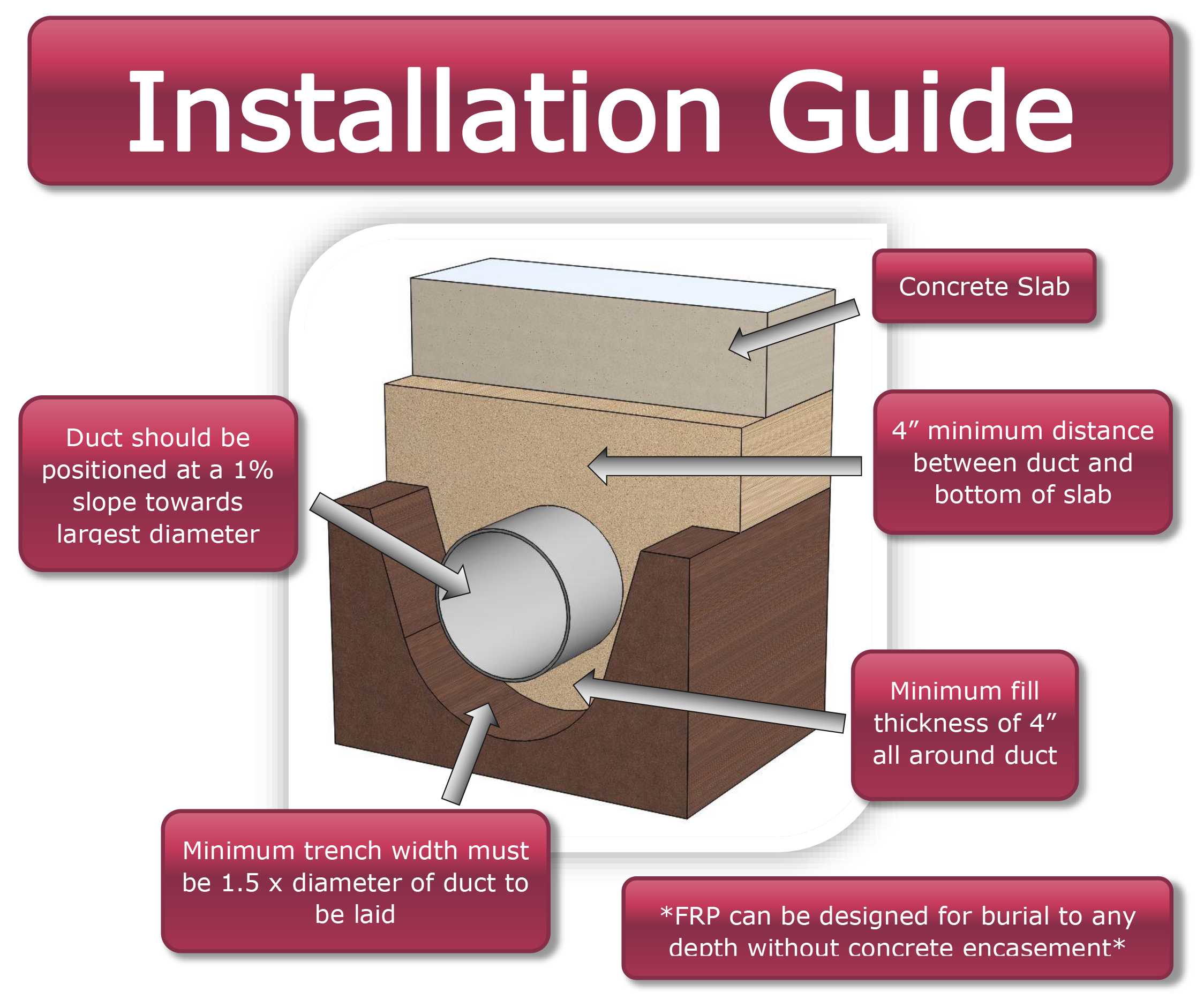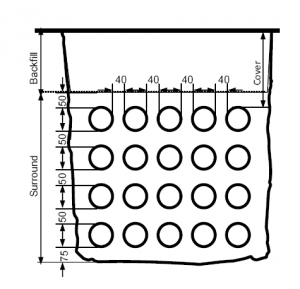

From gradeto the top of duct bank shall be a minimum of 610 mm (24 inches). The top layer of concrete on the duct bank shall be red concrete.Concrete encasement shall extend a minimum of 76mm (3 inches) from any conduit in the bank to the outside surface.In duct banks constructed with rigid steel conduit, unreinforced non-structuralconcrete may be used.Duct banks shall be provided with a minimum of 20 percent spare conduits ofeach size required.Conduit runs in duct banks shall be made continuous by the use of couplings.The spacers shall be placed at intervals of approximately 8 ft. Spacers to provide a minimum separation between conduits of 1 inch (25mm) for conduits 1.5 inches (38mm) or smaller and 2 inches (51mm) for conduits of 2 inches (51mm) or larger.Duct banks shall be constructed of either hot dipped galvanized rigid steel conduit encased in concrete or PVC conduit encased in reinforced concrete.Under ground Duct Bank Design Requirements All undergound conduits shall be concrete encased unless approved otherwise by the company. 34.5 kV and 13.8 kV cables shall be installed in one or two horizontal layers with separation as determined by ampacity derating studies and as required for future access for repair. A minimum separation of 305 mm (12 in) shall be maintained where possible. To facilitate maintenance, an adequate horizontal and vertical separation shall be provided between underground conduits or duct banks and foreign structures, such as water mains, sewers and gas lines. For separation of control, instrument and communication circuits, refer to article.

Direct-buried conduit is suitable for cables rated over 600 volts when it is buried to a depth in accordance with Table 1 in Direct Buried Cable Installation Trench Requirements.į. When encased in concrete in trenches outside of buildings, it is suitable for use with wires rated 90☌ or less.Į. Unless marked for a higher temperature, nonmetallic (plastic) conduit (Schedule 40 and Schedule 80) is intended for use with wires rated 75☌ or less.ĭ. All direct buried conduit shall be rigid hot dipped galvanized steel.Ĭ. Rigid metal conduit shall be used for underground installations whenever an extra high-strength installation is required such as in equipment foundations.ī. Conduit that runs under building slabs or roadways shall extend 1.5 meters beyond the building slab or edge of road.Ī. The minimum bending radius shall be 10 times the conduit diameter.į. In general, the depth of a conduit duct bank shall be established by the bending radius of the largest conduit in the duct bank. Where the conduit stubs up, the concrete envelope shall extend at least 150 mm (6 inches) above grade and shall be sloped.Į. The top of the concrete envelope shall be located a minimum of 610 mm (24 inches) below grade.
CONCRETE ENCASED DUCT BANK DESIGN INSTALL
Do not install any portion of the duct bank in the 45° cone of deflection from the low point of foundations.ĭ. In general, underground conduits and duct banks shall be installed below sewer lines and other piping.Ĭ. The location of all underground runs shall be selected with consideration for future structural installations in the area.ī. Underground Installation Requirements Underground RoutingĪ. Conduit material (RGS or PVC) for use in duct bank applications shall be selected per the requirements of this document.Duct banks shall be constructed with the use of concrete forms or by the use of precast duct banks.Conduit and/or cable for direct burial shall be selected per the requirements of this document.Plowing of cable or conduit directly into the earth is not permitted. Direct buried cable or conduit shall be installed in prepared trenches as defined in this specification.The following underground installation types are acceptable. Underground installations of electrical conduit, cable, conductors or duct bank systems must be approved by company.


 0 kommentar(er)
0 kommentar(er)
